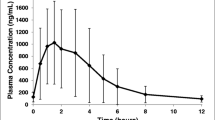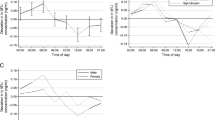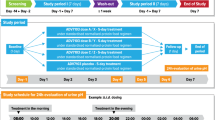Summary
Dose fractionation is known to reduce the toxicity of ifosfamide and also results in an increased production of alkylating metabolites. Administration by slow infusion using the convenience of ambulatory pumps is therefore of interest. We used HPLC to investigate the stability of ifosfamide in aqueous solution (either alone, solution A, or mixed with mesna, solution B) under various conditions over a 9-day period. At both ambient temperature in daylight and 27° C in a dark environment, there was no evidence of ifosfamide decay in either solution. However, at 37° C in a dark environment, a fall was detected in both solutions, which at 9 days amounted to a loss of 7% of the amount of ifosfamide present at time zero. At 70° C, levels of ifosfamide in both solutions fell within 72 h to markedly lower levels than controls, thus confirming that the methods used were indicative of stability. We conclude that ifosfamide, either alone or mixed with mesna, is stable for 9 days at temperatures up to 27° C; even at 37° C, the measured loss is small. The continuous infusion of ifosfamide over 7 days by ambulatory pump is now a practical proposition.
Similar content being viewed by others
References
Brade WP, Herdrich K, Varini M (1985) Ifosfamide — pharmacology, safety and therapeutic potential. Cancer Treat Rev 12: 1–47
Bryant BM, Jarman M, Ford HT, Smith IE (1980) Prevention of isophosphamide-induced urothelial toxicity with 2-mercaptoethane sulphonate sodium (mesnum) in patients with advanced carcinoma. Lancet II: 657–659
Lewis LD, Harper PG, Rogers HJ (1987) Fractionated ifosfamide chemotherapy produces a time dependent increase in its metabolism. Abstract 316, Proceedings, ECCO 4, November 1–4
Lind MJ, Margison JM, Cerny T, Thatcher N, Wilkinson PM (1989) Comparative pharmacokinetics and alkylating activity of fractionated intravenous and oral ifosfamide in patients with bronchogenic carcinoma. Cancer Res 49: 753–757
Margison JM, Wilkinson PM, Cerny T, Thatcher N (1986) A simple quantitative HPLC assay for ifosfamide in biological fluids. Biomed Chromatogr 1: 101–103
Morgan LR, Harrison EF, Hawke JE, Hunter HL, Costanzi JJ, Plotkin D, Tucker WG, Worrall PM (1982) Toxicity of single- vs fractionated-dose ifosfamide in non-small cell lung cancer: a multi-centre study. Semin Oncol 9: 66–70
Shaw IC, Rose JWP (1984) Infusion of ifosfamide plus mesna. Lancet I: 1353–1354
Author information
Authors and Affiliations
Rights and permissions
About this article
Cite this article
Radford, J.A., Margison, J.M., Swindell, R. et al. The stability of ifosfamide in aqueous solution and its suitability for continuous 7-day infusion by ambulatory pump. Cancer Chemother Pharmacol 26, 144–146 (1990). https://doi.org/10.1007/BF02897261
Received:
Accepted:
Issue Date:
DOI: https://doi.org/10.1007/BF02897261




